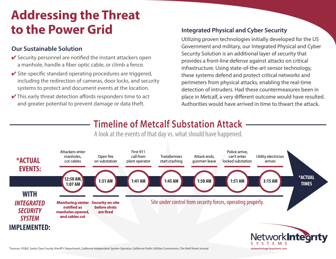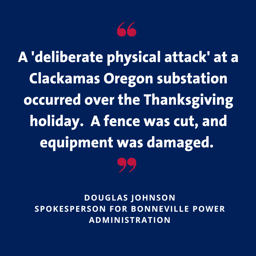.png?width=342&height=342&name=MicrosoftTeams-image%20(4).png)
Almost 10 years ago, an incident occurred at a Pacific Gas and Electric power substation near San Jose California (Metcalf) which nearly brought down power to the vast area served by the station. In short, bad actors attempted to disrupt power generation by firing high-powered rifles at the plant’s transformers. Only when remote alarms indicated that transformers at the station were overheating, one hour after the attack began, did the actions cause responders to investigate. Had fiber optic sensing technology been deployed by the substation, to detect the disruption of the communications cables which occurred as the precursor of the attack, or on the perimeter fence line surrounding the station, the event may have been prevented and the perpetrators apprehended. Eerily, now ten years later, numerous similar attacks have happened, within a month’s time in both Moore County and Maysville, North Carolina, Clackamas County, Oregon, and Washington with many other similar instances being reported to the authorities. This time however, these attacks are resulting in widespread power outages for more than three days.
 The shooting lasted 15 minutes until police arrived after being summoned by PG&E only because of the transformer overheat condition that was reported. The police observed that nothing appeared out of the ordinary and left the scene. Had fiber optic sensors been deployed on the fence or buried underground, the attackers’ approach would have been sensed and the gunshot noise could have been detected, and more important, located within meters of accuracy. While details of the recent events are still becoming known, the attack scenarios are remarkably like the Metcalf incident, except in some of these new cases, the perimeter fence was breached. Fiber optic sensing technology would have alarmed when the fence was approached, tampered with, and cut and once again could have minimized the damage that was done.
The shooting lasted 15 minutes until police arrived after being summoned by PG&E only because of the transformer overheat condition that was reported. The police observed that nothing appeared out of the ordinary and left the scene. Had fiber optic sensors been deployed on the fence or buried underground, the attackers’ approach would have been sensed and the gunshot noise could have been detected, and more important, located within meters of accuracy. While details of the recent events are still becoming known, the attack scenarios are remarkably like the Metcalf incident, except in some of these new cases, the perimeter fence was breached. Fiber optic sensing technology would have alarmed when the fence was approached, tampered with, and cut and once again could have minimized the damage that was done. 
For years, government agencies and military commands communicating National Security Information have been turning to Network Integrity Systems for modern technologies designed to detect attempted intrusions in real-time. Now, these same organizations with critical infrastructure and assets to protect (areas in which they must detect unauthorized access), are also deploying our technologies to protect their perimeters. Electric utilities should also go beyond merely making access to these places more difficult (e.g., using unmonitored fences and walls). They too should adopt modern technologies designed to detect intrusion attempts well before any damage is done.


.png?width=760&height=760&name=Proud%20FOSA%20Member%20(1).png)